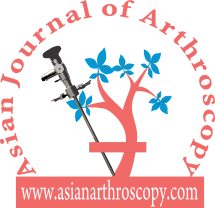Natural History of Rotator Cuff Tears
Volume 6 | Issue 1 | January-June 2021 | Page 36-38 | W. Jaap Willems
Author: W. Jaap Willems [1, 2]
[1] Lairesse Kliniek, Amsterdam, The Netherlands.
[2] International Knee and Joint Centre, Abu Dhabi, UAE.
Address of Correspondence:
Dr. W. Jaap Willems,
Shoulder Unit, Lairesse Kliniek, Amsterdam, The Netherlands.
International Knee and Joint Centre, Abu Dhabi, UAE.
E-mail: w.j.willems@xs4all.nl
Abstract
Rotator cuff tears are a frequent phenomenon with an increasing incidence when the patient gets older. A considerable number of tears remain asymptomatic during a lifetime. However, still, a substantial number of asymptomatic tears become symptomatic. There is, at present evolving evidence that surgical treatment of small to medium-sized tears does better than conservative treatment, even after a long term follow-up. A treatment algorithm is suggested to help the clinician in decision making, where tear size and age are important factors in the prognosis of surgical treatment.
Keywords: Rotator cuff; Ruptures; Natural historyf tears; Partial rotator cuff tears; Subscapularis tears; Geometric Classification; Arthroscopic Classification; Rotator cuff retraction; Rotator cuff tendon quality; Prognosis for Rotator Cuff tears.
References
1. Codman EA. Complete rupture of the supraspinatus tendon. Operative treatment with report of two successful cases. 1911. Boston Med Surg J.1911;164:708-710.
2. Neer 2nd CS. Anterior acromioplasty for the chronic impingement syndrome in the shoulder: a preliminary report. J Bone Joint Surg Am.1972;54:41-50.
3. Teunis T, Lubberts B, Reilly BT, Ring D. A systematic review and pooled analysis of the prevalence of rotator cuff disease with increasing age. J Shoulder Elb Surg. 2014;23(12):1913–21.
4. Milgrom C, Schaffler M, Gilbert S, van Holsbeeck M. Rotator-cuff changes in asymptomatic adults. The effect of age, hand dominance and gender. J Bone Joint Surg Br. 1995;77(2):296–8.
5. Yamamoto A, Takagishi K, Osawa T, et al. Prevalence and risk factors of a rotator cuff tear in the general population. J Shoulder Elb Surg 2010; 19(1), 116-120
6. Codman EA. The pathology associated with the rupture of the supraspinatus tendon. Ann Surg. 1931;93:348-359.
7. Kim HM, Dahiya N, Teefey SA, MiddletonWD, Stobbs G, Steger-May K, et al. location and initiation of degenerative rotator cuff tears: an analysis of three hundred and sixty shoulders. J Bone Joint Surg Am. 2010;92(5):1088–96.
8. Kim HM, Dahiya N, Teefey SA, Keener JD, Galatz LM,Yamaguchi K. Relationship of tear size and location to fatty degeneration of the rotator cuff. J Bone Joint Surg Am. 2010;92(4):829–39.
9. Keener JD, Wei AS, Kim HM, Steger-May K, Yamaguchi K. Proximal humeral migration in shoulders with symptomatic and asymptomatic rotator cuff tears. J Bone Joint Surg Am.2009;91(6):1405–13.
10) Keener JD, Skelley NW, Stobbs-Cucchi G, Steger-May K,Chamberlain AM, Aleem AW, et al. Shoulder activity level and progression of degenerative cuff disease. J Shoulder Elb Surg.2017;26(9):1500–1507.
11. Dunn WR, Kuhn JE, Sanders R, An Q, Baumgarten KM, BishopJY, et al. Symptoms of pain do not correlate with rotator cuff tear severity: a cross-sectional study of 393 patients with a symptomatic atraumatic full-thickness rotator cuff tear. J Bone Joint Surg Am.2014;96(10):793–800.
12. Hebert-Davies J, Teefey SA, Steger-May K, Chamberlain AM,Middleton W, Robinson K, et al. progression of fatty muscle degeneration in atraumatic rotator cuff tears. J Bone Joint Surg Am. 2017;99(10):832–839.
13. Chalmers PN, Salazar DH, Steger-May K, Chamberlain AM,Stobbs-Cucchi G, Yamaguchi K, et al. Radiographic progression of arthritic changes in shoulders with degenerative rotator cuff tears. J Shoulder Elb Surg. 2016;25(11):1749–55.
14. Moosmayer S, Gärtner AV, Tariq R. The natural course of nonoperatively treated rotator cuff tears: an 8.8-year follow-up of tear anatomy and clinical outcome in 49 patients. J Shoulder Elb Surg. 2017;26(4):627–634.
15. Moosmayer S, Lund G, SeljomUS, Haldorsen B, Svege IC, Hennig T, et al. Tendon repair compared with physiotherapy in the treatment of rotator cuff tears: a randomized controlled study in 103 cases with a five-year follow-up. J Bone Joint Surg Am.2014;96(18):1504–1514.
16. Moosmayer S, Lund G, Seljom US, Haldorsen B, Svege IC, Hennig T, et al. At a 10-Year Follow-up, Tendon Repair Is Superior to Physiotherapy in the Treatment of Small and Medium-Sized Rotator Cuff Tears. J Bone Joint Surg m.2019;101(12):1050-1060.
17. Bassett RW, Cofield RH. Acute tears of the rotator cuff. The timing of surgical repair. Clin Orthop 1983;175:18-24.
18. Mall NA,Lee AS, B.S, Chahal J,Sherman SL,Romeo AA, Verma NN, Cole BJ. An Evidenced-Based Examination of the Epidemiology and Outcomes of Traumatic Rotator Cuff Tears. Arthroscopy 2012 Feb:29(2):366-76
19. Loew M, Magosch P, Lichtenberg S, Habermeyer P, Porschke F. How to discriminate between acute traumatic and chronic degenerative rotator cuff lesions: an analysis of specific criteria on radiography and magnetic resonance imaging. J Shoulder Elb Surg.2015;24(11):1685–93.
20. Tan M, Lam PH, Le BTN, Murrell GAC. Trauma versus no trauma: an analysis of the effect of tear mechanism on tendon healing in 1300 consecutive patients after arthroscopic rotator cuff repair. J Shoulder Elb Surg. 2016;25(1):12–21.
21. Petersen SA, Murphy TP. The timing of rotator cuff repair for the restoration of function. J Shoulder Elb Surg. 2011;20(1):62–8.
22. Collin P, Kempf J-F,Molé D, Meyer N, Agout C, Saffarini M, et al.Ten-year multicenter clinical and MRI evaluation of isolated supraspinatus repairs. J Bone Joint Surg Am. 2017;99(16):1355–1364.
| How to Cite this article: Willems WJ | Natural History of Rotator Cuff Tears | Asian Journal of Arthroscopy | January-June 2021; 6(1): 36-38. |



Leave a Reply
Want to join the discussion?Feel free to contribute!